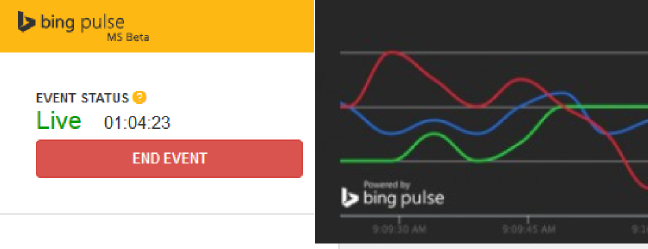Bing Pulse and data collection for market research
Judging by the buzz and article sharing going on last week, there was a lot of interest and worry about Microsoft launching their own market research platform. Branded as part of ‘Bing’, their offering, called ‘Pulse’ has actually been around for a while

Judging by the buzz and article sharing going on last week, there was a lot of interest and worry about Microsoft launching their own market research platform. Branded as part of ‘Bing’, their offering, called ‘Pulse’ has actually been around for a while, and is still geared around collecting feedback from live events, especially political discussions.
I can see why this move might have a lot of companies worried, it seems to me that the market research arena is crowded with start-ups and established firms offering platforms, or ‘communities’ for collecting participant data. There’s LiveMinds, Aha!, VisionLive, a quick search will bring up dozens of competitors. So an entry into the market from an organisation with deep pockets and brand awareness like Microsoft may well have many looking to see how this develops. However, with my own limited time with Pulse, I don’t think there is much to worry about yet.
First of all, Pulse is currently entirely focused on one niche, feedback on live events. There are no tools to do anything like advert or creatives validation, no proper survey tools or interactive online focus groups. The MO is very much quantitatively focused, with very little option to capture qualitative feedback at this time. Secondly, it seems to have a lot of limitations, and in this beta state, almost no documentation.
I quickly got stuck trying to create a real-time voting question, with a mandatory box for ‘response theme’ that was greyed out, but wouldn’t continue without being completed. The ‘help’ tools just link to a generic Bing help website, which don’t contain any content about Pulse. The layout is a little confusing, getting you stuck in a strange loop between the ‘Live Dashboard’ and ‘Pulse Options’, and it’s also slow: get used to seeing the little flapping loading logo after every action.
As for integration, the only option at the moment seems to be the API, which only has four available calls. There doesn’t seem to be any way to get results (especially those not covered by those API calls) out from the platform: I can’t see any CSV export or the like. Also, considering the powerful analytic options available through the Azure platform, it’s disappointing not to see any easy integration there. In short, far from being a quick DIY solution, you will need someone to programme yet another API into your platform to do anything more than look at a few graphs on the Pulse platform.
I want to stress that this was hardly a detailed review and test of the capabilities of the platform, my opinions are based just on playing with it for an hour or so. However, it is nice to be able to try it out with just a registration, personally I don’t like products where the demo is locked away and difficult to try out. It’s a competitive market, and I feel more inclined to trust software that the developers aren’t shy of showing off!
Now, I understand that most market research providers are not so much worried about the current feature set of Pulse, but what this entry into the field means in the future, especially for a product that Microsoft is content to offer for free at this time. But I would echo some of the comments made in the Greenbook article by Leonard Murphy, that it usually doesn’t make sense for market research firms to do their own their own quantitative data collection. The future, he says, is integrating with data collection tools and adding value in terms of insight, custom development and consultation.
And that is the crux with all these market research platforms: they are primarily data collection tools, with limited analytics. Pulse doesn’t seem to have anything on this front at the moment, but with too many of these solutions, the insight stops with a couple of graphs or statistics. I feel there is still the need to integrate with another tool, or draw from extensive market research analytic experience to make anything from the data once it has been collected. It maybe that most clients don’t expect or require any kind of rigour in the breakdown of project results, especially when it comes to qualitative data. I am still yet to see anything that looks to me like a true end-to-end platform for market research, but am willing to be proved wrong!
At the moment, there are some great and flexible tools for collecting customer data online, be it quantitative or qualitative. But these are ubiquitous, and very cheap to run – we host an online survey platform for our customers for free, just as a convenience. Yet getting to answers and insight from that data usually requires an additional analytical step, especially for qualitative research. As I’ve said before, the most difficult step is understanding the data and how you integrate analytics into your workflow. Increasingly the data collection platform you choose, and how much you pay for it will not be an issue.
